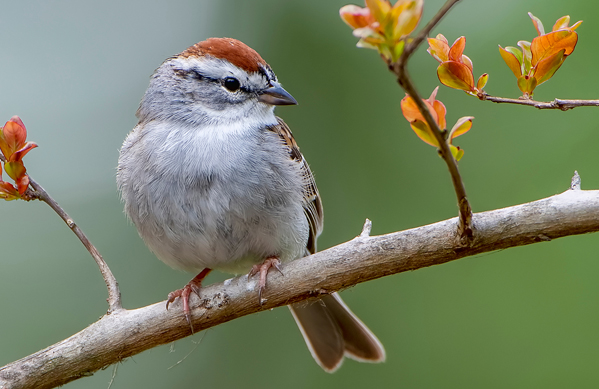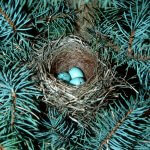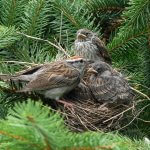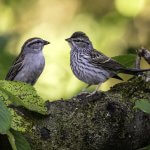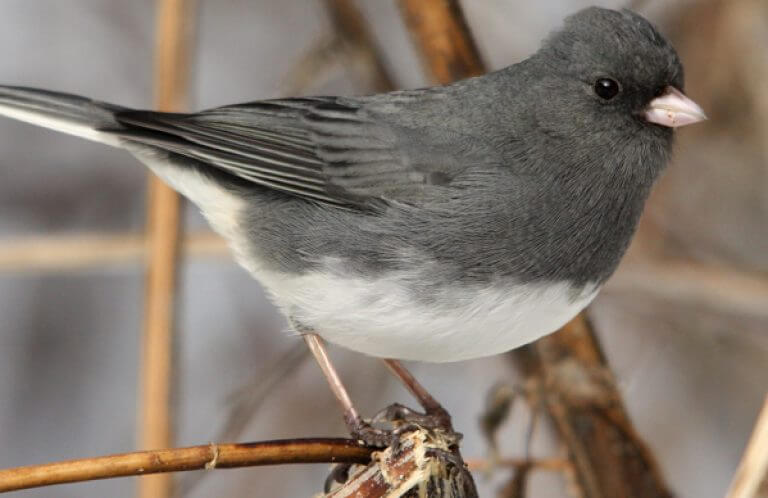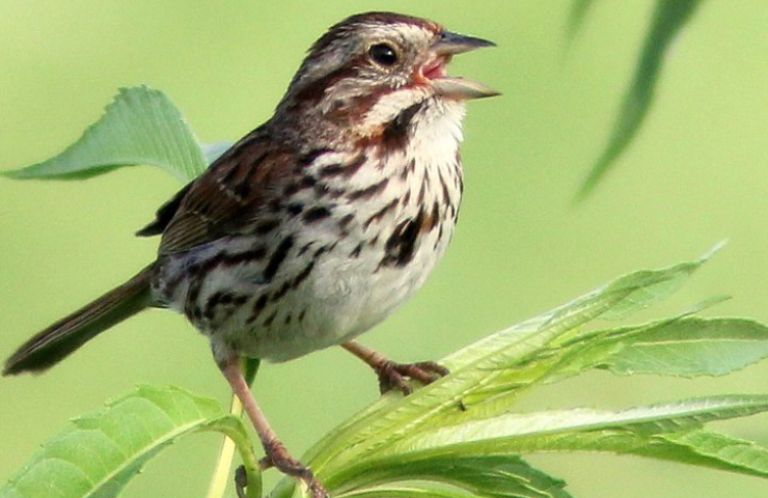About the Chipping Sparrow
The dainty little Chipping Sparrow, like the Blue Jay and Northern Cardinal, is a familiar sight in suburbs and backyards across North America. In the springtime, this sparrow is easily recognized by its bright reddish crown, bold black and white facial pattern, and unstreaked gray breast and rump. This coloration becomes less conspicuous during the fall and winter. Juvenile birds are heavily streaked, and might be mistaken for another bird species altogether, such as a House Finch.
Edward Forbush, a noted 19th century ornithologist, called the Chipping Sparrow “the little brown-capped pensioner of the dooryard and lawn, that comes about farmhouse doors to glean crumbs shaken from the tablecloth by thrifty housewives.”
The "Chippie" gets its most familiar nickname from its high-pitched song. Another of its common nicknames has fallen out of use as times have changed.
Horses and Hair Birds
The Chipping Sparrow was once known as the "hair bird" due to its habit of lining its nests with horse hair, which was readily available when horses were the main form of transportation. Once horses gave way to automobiles, Chipping Sparrows had to switch to other types of hair to line their nests. Although the nickname of "hair bird" went the way of the horse and carriage, this sparrow still seeks soft hair to line its nest — now mostly from deer, cows, and smaller mammals.
Songs and Sounds of the Chipping Sparrow
True to its name, the Chipping Sparrow's song is a rapid, mechanical-sounding trill. Only the male sings, usually from a high perch, as he establishes and then holds his nesting territory.
The trilled songs of the Dark-eyed Junco and Worm-eating Warbler can easily be confused with that of the Chippie. See if you can tell the difference!
Listen here:
(Audio: Hal Mitchell, XC314692. Accessible at www.xeno-canto.org/314692 · Jeremy Minns, XC381584. Accessible at www.xeno-canto.org/381584 · Ryan P. O'Donnell, XC138781. Accessible at www.xeno-canto.org/138781 · J.R. Rigby, XC315096. Accessible at www.xeno-canto.org/315096)
Chipping Sparrow Breeding and Feeding
Familiar Feeding Habits
The Chipping Sparrow is easy to observe as it feeds, since it often forages on the ground in open suburban habitats. It is a common sight under backyard feeders, where it favors sunflower seeds and cracked corn.
Like other members of its family, such as the Song Sparrow and the White-throated Sparrow, the Chipping Sparrow switches its diet with the seasons, feeding mainly on insects during the spring and summer and seeds in fall and winter. (This reliance on insects is one of the reasons native plants, which support insect diversity, are so important.)
Chippies are quite sociable during the winter and can be found feeding in mixed flocks with other sparrows such as White-crowned and Grasshopper Sparrows, along with other bird species including the Eastern Bluebird and Yellow-rumped Warbler.
Prolific Producer
Although Chipping Sparrows were once considered seasonally monogamous, a study from Ontario suggests that polygyny (in which a male mates with many females) and extra-pair copulations may also occur. Mated males sometimes travel outside of their territories to mate with other females.
Once mated, the female builds a flimsy cup-shaped nest of grasses and rootlets lined with animal hair and plant fibers. The nest is usually well-hidden in a dense shrub, vine tangle, or low in a thick conifer. The female incubates two to five blue-green eggs and broods the hatchlings alone, although the male brings food while she's on the nest.
Prolific as well as adaptable, the Chipping Sparrow usually produces two broods per season; the male cares for fledglings from the first brood while the female starts a second. Fledglings remain near the nest with their parents for another few weeks. Once fully independent, they form flocks with other young birds, eventually joining groups of post-breeding adults before migration begins.

Chipping Sparrow Region and Range

Adaptability is one of the main reasons this small sparrow is so widespread. Many sparrow species occur only in grasslands or shrublands, but the Chipping Sparrow can be found in a wide variety of open forests and edges, favoring those with lots of shrubs and other undergrowth. It's not limited to these areas, though, and is also common in suburban yards and parks, golf courses, orchards and agricultural areas, and many other developed landscapes.
Five subspecies of Chipping Sparrow are recognized. Three of these breed in North America and are partial migrants, wintering in the southeastern United States and Mexico. The other two remain on their Mexican and Central American ranges year-round.
Conservation of the Chipping Sparrow
The Chipping Sparrow remains a common and widespread species throughout its range. Its populations may even have increased due to its ready adaptation to human-modified habitats.
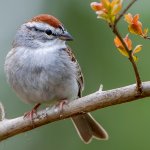
Help support ABC's conservation mission!
However, the increased habitat provided by humans is sometimes a double-edged sword. Chippies frequently encounter human-made threats, including exposure to pesticides and predation by free-roaming cats. During migration, some Chipping Sparrows fatally collide with buildings and communications towers.
In addition, the Chipping Sparrow, like the Yellow Warbler, White-eyed Vireo, and many other songbirds, is commonly parasitized by the Brown-headed Cowbird, which also thrives in these fragmented landscapes.
ABC helps to reduce the impact of these threats on the Chipping Sparrow and other bird species, including through our Cats Indoors program, which encourages pet owners to keep cats and birds safe. Our Collisions program helps to prevent communications tower collisions and fatalities, and provides solutions to prevent bird collisions with glass, including at home windows.
Get Involved
Policies enacted by the U.S. Congress and federal agencies, such as the U.S. Fish and Wildlife Service, have a huge impact on America's birds. You can help shape these rules for the better by telling lawmakers to prioritize birds, bird habitat, and bird-friendly measures. To get started, visit ABC's Action Center.
Living a bird-friendly life can have an immediate impact on the birds around you. Doing so can be as easy as adding native plants to your garden, avoiding pesticides, and keeping cats indoors. To learn more, visit our Bird-Friendly Life page.
American Bird Conservancy and our Migratory Bird Joint Venture partners have improved conservation management on more than 6.4 million acres of U.S. bird habitat — an area larger than the state of Maryland — over the last ten years. This is a monumental undertaking, requiring the support of many, and you can help by making a gift today.





































